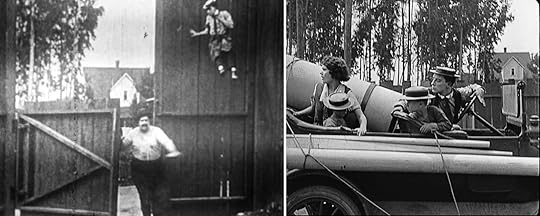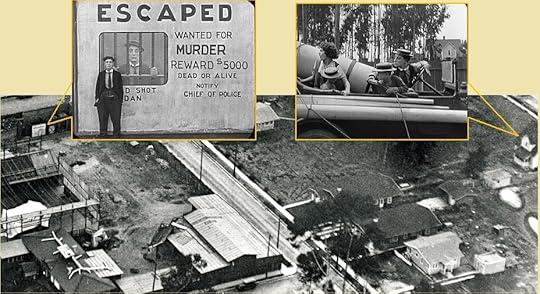Found – a new version of Keaton’s The Blacksmith and the tales it tells

NEW FOOTAGE – Buster lights a stogie – a view perhaps not seen in America for 90 years

NEW FOOTAGE
As reported in Variety, lightning struck twice for film historian Fernando Pena. The same gentleman from Argentina who discovered a complete version of the Fritz Lang 1927 epic Metropolis has now unveiled a 9.5 mm print of Buster Keaton’s 1922 short The Blacksmith that contains unique scenes that do not appear in any other version of the film. For example, this new footage shows Buster behind the wheel of his jalopy, a stogie clenched proudly between his teeth, while above we see him light the cigar by using what appears to an automobile cigarette lighter. As shown below, this discovery also provides tantalizing new information about Keaton’s small studio, located in Hollywood within Lillian Way, Eleanor, Cahuenga, and Romaine.

The Keaton Studio barn as it appears in The Blacksmith, left, looking west down Eleanor towards Cahunega, and as it appears looking east from Cole Street, in Sherlock Jr. Click the photo to see the tiny barber shop (left), and at right the back of the barber shop and two bungalows, all discussed later below.

NEW – a special set
The new material runs for over four minutes, and involves novel jokes, characters, and settings that differ from the widely distributed version of the film available from Kino-Lorber. For example, the Virginia Fox character now has a father who makes an appearance, while Buster and Big Joe Roberts chase each other around a small set, barely more than a shed, designated as the local “Chamber of Commerce.” Buster also attempts to propose to Virginia, pleading he won’t always be a blacksmith, which makes more plausible their elopement later in the film.

A circa 1922 view looking SE towards the corner of the studio barn (box) and the Chamber of Commerce shed (oval) built for the novel scenes in The Blacksmith. The barber shop (1) and bungalows (2) and (3) are discussed above and below. HollywoodPhotographs.com
The Chamber of Commerce shed built for the novel scenes from The Blacksmith stood on a small vacant lot on Cahuenga directly across the street from the Keaton Studio, and appears in a couple of circa 1922 aerial photographs of the site. The tiny shed’s appearance in these photos had always puzzled me, but thanks to Mr. Pena’s discovery, I now know what the shed was and why it was there. The shed stood on the same vacant lot where Buster would later build the dormitory set for his 1927 feature College.

NEW FOOTAGE left – The Boat, right, both looking west from the studio towards the back of 1022 Cole Street

1022 Cole Street
The novel footage from The Blacksmith provides another view from the Keaton Studio towards the house standing to the west on 1022 Cole Street. The house not only appears behind the studio fence during scenes from The Boat (1921) (above) and in Day Dreams (1922), but also portrayed Katherine McGuire’s home (to the right) in Buster’s 1924 feature Sherlock Jr.

Circa 1921. At left, the ESCAPED poster set from The Goat beside the open air filming stage – at right the back of 1022 Cole Street from The Boat. The empty lot covered by both movie frames is where the Chamber of Commerce shed would later be built for The Blacksmith. The Keaton Studio barn stands at the bottom.
The new footage from The Blacksmith also helps to pinpoint the time the Keaton Studio upgraded from an open air filming stage to a more modern closed over stage. As shown above, the shooting stage remained open to the elements during the filming of Keaton’s The Goat in 1921. The novel images from The Blacksmith below show that the former open air stage was already covered over by the time filming began early in 1922, suggesting the stage construction might have taken place late in 1921.

Click to enlarge. NEW FOOTAGE at left. The view looks east from the vacant lot on Cahuenga towards the Keaton Studio across the street. By now the filming stage is covered over.

NEW FOOTAGE
During the novel scenes, Buster encounters a prop billboard that looks like an automobile, labelled with a sign that reads “The Senseless ‘Six’,” perhaps contemporary slang or a joke that eludes me. The billboard was built on the same vacant lot near the Chamber of Commerce set. The shot above shows Buster climbing from under the back of the sign. Although the above image is confusing, if you look closely you will first discern the steering wheel and the outline of the car, then further back the Keaton Studio fence across the street, with its pattern of alternating taller and shorter fence boards, and then beyond the jumble of sheds, doors, and roof edges that comprise the west side of the studio.

The covered stage, at left, in The Balloonatic
I already knew that by 1923 the Keaton filming stage was covered over, when Buster shot The Balloonatic, because you can see the covered stage in the far left background during the balloon launching scene (at right), filmed from a different vacant lot east of the studio. Buster’s famous short film Cops (1922) was filmed during December 1921 – January 1922, immediately preceding The Blacksmith. Interestingly, Cops is the only Keaton movie that has no interior scenes whatsoever. Perhaps the shooting stage roof was constructed late in 1921 during the production of Cops. Is it possible Cops was deliberately structured with no interior scenes to be filmed on the shooting stage in order to give the studio carpenters free reign to complete their work?
Of further interest, although The Blacksmith was shot during January – February 1922, it was held back, and released out of order on July 21, 1922, only after the June 12, 1922 release of Keaton’s subsequently produced short My Wife’s Relations. There is visual proof that some of the horseback scenes in “our” American Kino-Lorber version of The Blacksmith were filmed several months apart, as a number of lumberyard buildings pop up in the background between different scenes filmed at the same setting. Perhaps Mr. Pena’s version was filmed early in 1922, quickly shipped overseas, and then found to be unsatisfactory for American audiences, calling for new substitute footage to be filmed months later, perhaps even immediately before the July American release. This gap in filming would allow sufficient time for the new buildings to appear in the background, and would explain why different versions of the film exists, and why the movie was held up for domestic release. I hope to write about this gap in filming in a later post.

Click to enlarge. A circa 1920 view of the same vacant lot (center) west of the Keaton Studio. The bungalows to the right of the lot appear three times below. A tiny barber shop (discussed below) and cafe would later be built to the right of the bungalows. The prison guard towers and set from Convict 13 (1920) and the “U”-shaped tenement set from Neighbors (1920) stand in the corner of the Keaton Studio. Charlie Chaplin built his tenement set for Easy Street (1917) at the same spot. HollywoodPhotographs.com
Closing this post, above is a circa 1920 view, looking to the NW, of the small vacant lot on Cahuenga, across from Buster’s studio, where the novel Chamber of Commerce shed would later be built. Below is the back of the shed, with a matching view, looking north, of the twin bungalows across from the studio, as they appear during Keaton’s feature comedy College. The red ovals below mark a unique feature on the side of the barber shop discussed at the top of this post.

NEW FOOTAGE left, a scene from Keaton’s College, right, both looking north up Cahuenga and showing the bungalow porches across from the Keaton Studio, and the south side of the barber shop discussed above.

The Cahunega bungalows appearing in The Boat
The same bungalows on Cahuenga shown above also appear across the street (at right) during this scene from The Boat.
In all, Keaton filmed over four dozen scenes and insert shots for his movies at or adjacent to his small studio. You can read about further studio appearances in Day Dreams and in Sherlock Jr. at this prior post Mr. Keaton’s Neighborhood.

The Keaton Studio, circa 1921, within Lillian Way, Eleanor, Cahuenga, and Romaine – the barn to the upper left, with 1022 Cole Street (oval) and the vacant filming lot (brown box) across from the studio.
All NEW FOOTAGE scenes provided courtesy of Mr. Fernando Pena, to whom I extend my congratulations and sincere appreciation for sharing his remarkable discovery.
All other Keaton movie frame images licensed by Douris UK, Ltd.
Filed under: Buster Keaton, Keaton Studio, The Blacksmith Tagged: Buster Keaton, Fernando Pena, Hollywood, Keaton Locations, Keaton Studio, Metropolis, Silent Comedians, Silent Comedies, Silent Movie Locations, Silent Movies, The Blacksmith, then and now, Variety




